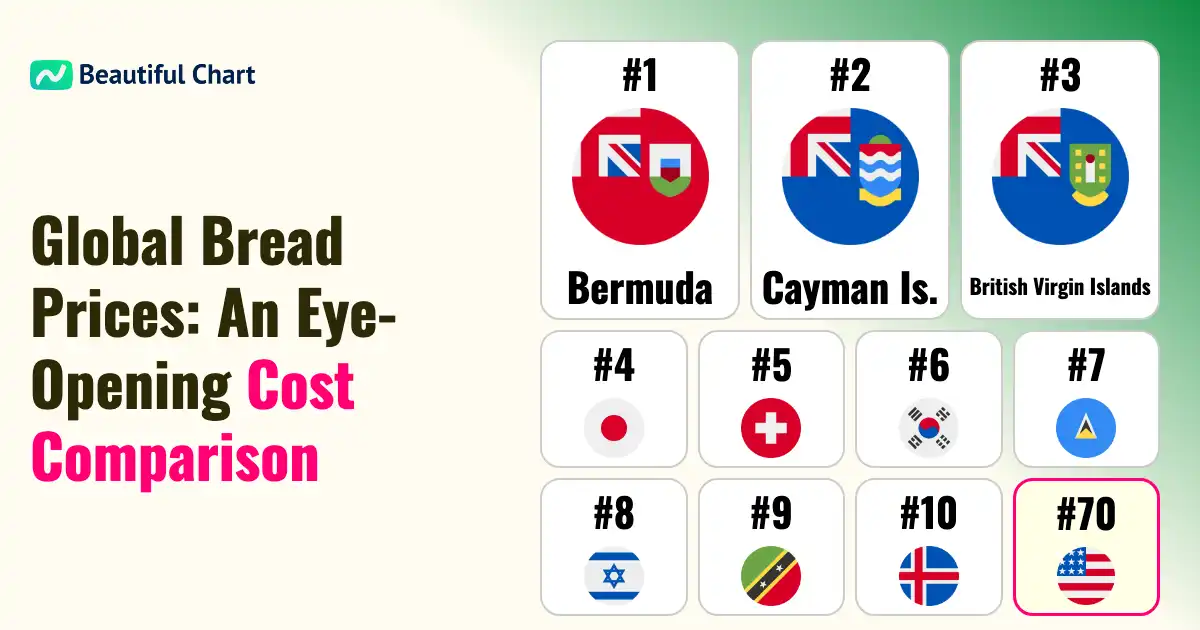
You Won't Believe How Much a Loaf of Bread Costs in These Countries! (Spoiler: It's INSANE)
- ASUMUP
- Economy
- September 21, 2025
Bread. It's the most basic of staples, a cornerstone of meals in cultures all around the world. Whether it's a fluffy white loaf, a rustic sourdough, or a simple flatbread, we often take its affordability for granted. But what if we told you that the price of this everyday item varies dramatically across the globe? The Bread Price Index gives us a fascinating glimpse into the cost of living in different countries by comparing the price of a simple loaf of bread against a global average set at 100.
This ranking isn't just about bread; it's a powerful indicator of a country's economic landscape, revealing insights into its reliance on imports, labor costs, and overall market dynamics. In this post, we're diving deep into the top 10 countries where buying a loaf of bread can feel more like a luxury purchase. Prepare to be surprised, as many of the names on this list are beautiful, popular destinations with a hidden high cost for everyday necessities.
World's Most Expensive Bread?!
- 1st Bermuda - 318.5
- 2nd Cayman Islands - 252.8
- 3rd British Virgin Islands - 223
- 4th Japan - 206.1
- 5th Switzerland - 205
- 6th South Korea - 198.2
- 7th St. Lucia - 196.4
- 8th Israel - 195.8
- 9th St. Kitts & Nevis - 189.3
- 10th Iceland - 185
- 70th USA - 117.4
70th USA - 117.4
Landing at 70th place, the United States has a bread price index of 117.4, which is slightly above the global average. This might seem surprising for a country known for its vast agricultural lands, but several factors are at play. The sheer size of the country means transportation and logistics costs can significantly add to the final price of a loaf of bread, varying widely from state to state.
Furthermore, the American market is incredibly diverse, offering everything from mass-produced sliced bread for a couple of dollars to high-end artisanal sourdough loaves that can cost over ten dollars. This wide range, combined with rising labor costs and the growing demand for organic and specialty ingredients, pulls the national average up. So, while basic bread remains relatively affordable, the premiumization of the market contributes to its overall index score being higher than 100.
10th Iceland - 185
Rounding out the top ten is Iceland, the Nordic island nation with a bread price index of 185. Its ranking is a classic case of geographic isolation and a challenging agricultural climate. It is virtually impossible to grow wheat commercially in Iceland, so the country is 100% reliant on imports for its flour, making it subject to volatile global markets and high shipping costs.
Iceland also has very high labor costs and a strong commitment to quality, which is reflected in the price of its goods. The country has recovered strongly from its past economic crises, but it remains an expensive place to live and visit. For Icelanders, paying a premium for imported goods is a simple fact of life, and bread is no exception to this rule.
9th St. Kitts & Nevis - 189.3
The dual-island nation of St. Kitts & Nevis is another Caribbean entry on this list, with a bread price index of 189.3. The story here is consistent with its regional neighbors: a small population and an economy dominated by high-end tourism. This economic focus means local production of basic commodities is minimal, and nearly all food, including flour, must be imported, which is inherently expensive.
The nation's prosperity is tied to attracting wealthy visitors and investors, which creates a high-cost local economy. Everything from labor to real estate is priced to match this market. As a result, the cost of producing or selling anything, even a simple loaf of bread, is significantly higher than in countries with more diversified, production-based economies.
8th Israel - 195.8
Israel's place in the top ten with an index of 195.8 is linked to its unique economic and geographic position. It has a highly advanced, high-tech economy with corresponding high wages, but it is also a country with limited natural resources, particularly water, which affects agriculture. While Israel does grow some wheat, it still relies heavily on imports to meet domestic demand.
The country's overall high cost of living, particularly in major cities like Tel Aviv, directly impacts food prices. Furthermore, regulations, including kashrut (kosher) supervision for many bakeries, can add to production costs. This blend of a modern high-wage economy with agricultural and logistical constraints contributes to the high price of bread and other basic foodstuffs.
7th St. Lucia - 196.4
Returning to the Caribbean, St. Lucia ranks seventh with a bread price index of 196.4. As a Small Island Developing State, St. Lucia's economy is heavily dependent on tourism and agriculture, but not for wheat production. The island's tropical climate is unsuitable for growing wheat, so all flour must be imported, making the nation susceptible to global supply chain disruptions and shipping costs.
The price of bread on the island reflects these high import costs, along with expenses related to energy and transportation in a mountainous terrain. While local bakeries are a staple of community life, the foundational ingredient for their products comes from far away. For tourists enjoying the beautiful beaches, the high price of simple goods like bread is a stark reminder of the economic challenges faced by island nations.
6th South Korea - 198.2
South Korea's position at sixth place with an index of 198.2 often surprises people, but it reflects a significant shift in the nation's diet and economy. Similar to Japan, rice has historically been the main staple, and bread was considered a Western novelty. However, its popularity has surged, leading to the rise of premium bakery chains and artisanal shops that command high prices for their products.
South Korea imports almost all of its wheat, making it vulnerable to global price fluctuations and import tariffs. The country's dense urban population and complex supply chains also add to the cost. The booming 'bakery cafe' culture has positioned bread not just as a food item, but as part of a lifestyle experience, allowing retailers to charge a premium that consumers are willing to pay.
5th Switzerland - 205
It's no surprise to find Switzerland, a country famous for its high quality of life and equally high cost of living, in the top five with an index of 205. Swiss bread prices are a product of a 'high-cost island' in the middle of Europe. The country's strong currency, the Swiss Franc, makes imports expensive, while its policy of agricultural protectionism raises the price of both domestically grown and imported ingredients to support local farmers.
Extremely high wages across all sectors, from farming to baking to retail, are a major driver of the final consumer price. The Swiss consumer market places a strong emphasis on quality and is generally less price-sensitive than its European neighbors. This combination of a strong currency, agricultural tariffs, and the highest labor costs in Europe ensures that a fresh loaf from a 'Bäckerei' will be a costly affair.
4th Japan - 206.1
Breaking the pattern of small island territories, Japan ranks fourth with a high bread price index of 206.1. While Japan is a major global economy, its food prices are notoriously high for several reasons. Traditionally, rice is the primary staple carbohydrate, and bread is often viewed as a more artisanal or specialty product, especially the high-quality, soft 'shokupan' that is popular there. This perception allows for higher pricing in the market.
Furthermore, Japan has a highly protected agricultural market and relies on imports for the majority of its wheat. Complex, multi-layered distribution systems, high labor costs, and a general consumer expectation for premium quality and packaging all contribute to the final price. In Japan, you're not just paying for the bread; you're paying for the meticulous process, presentation, and quality that defines much of its food culture.
3rd British Virgin Islands - 223
The British Virgin Islands (BVI) secures the third spot with an index of 223, reinforcing the trend of small, tourism-dependent islands having incredibly high food costs. The BVI's economy is overwhelmingly reliant on tourism, particularly the high-end yachting and sailing community, along with offshore financial services. This economic structure necessitates importing almost everything, from construction materials to, of course, flour and other baking ingredients.
The archipelago's geography also plays a significant role in these inflated prices. Supplying a population spread across multiple islands is logistically more complex and expensive than supplying a single landmass. Every item on a supermarket shelf, including a loaf of bread, has a price that reflects these significant shipping and distribution hurdles, on top of the already high cost of labor in a tourism-driven economy.
2nd Cayman Islands - 252.8
Coming in at a clear second place, the Cayman Islands boasts a bread price index of 252.8. Much like Bermuda, this British Overseas Territory in the Caribbean is a world-renowned financial center and a magnet for wealthy tourists. This economic model creates a high-cost environment where everyday items carry a premium price tag. The islands have limited local agriculture and must import the vast majority of their food supplies, including all the necessary components for making bread.
The logistics of shipping everything to a small island chain inherently adds to the cost. When you combine these import expenses with high local wages and the general cost of living required to support its finance and tourism sectors, it's easy to see why a simple loaf of bread costs more than double the world average. This high price is a trade-off for the tax advantages and idyllic lifestyle the islands offer.
1st Bermuda - 318.5
Taking the top spot with an astonishing index of 318.5, Bermuda is officially the most expensive place in the world to buy a loaf of bread. This means bread prices here are more than three times the global average. This staggering cost is a direct reflection of Bermuda's unique economic situation as a small, remote island in the North Atlantic. The island has very little arable land, meaning nearly all of its food, including essential ingredients like wheat and flour, must be imported over long distances.
The high cost is further compounded by Bermuda's status as a major offshore financial hub and luxury tourist destination. This drives up wages, real estate, and the overall cost of doing business, all of which get passed on to the consumer. For residents and visitors alike, the price of everyday groceries is a constant reminder of the economic realities of living in this isolated paradise.
Other Posts in the Economy
Categories
- National Rankings(43)
- Science & Technology(1)
- Sports(24)
- Economy(30)
- Society(12)
- Culture(7)
Recent Posts
![Bayern Spent HOW MUCH on Harry Kane?! Ranking Their Top 10 Biggest Signings Ever]() A deep dive into Bayern Munich's ten most expensive transfers, exploring how the club's spending strategy has evolved to chase European glory.
A deep dive into Bayern Munich's ten most expensive transfers, exploring how the club's spending strategy has evolved to chase European glory.![Arsenal's Record-Shattering Spree: From a €116M Gamble to a Flop, Who Was Worth the Cash?]() A deep dive into Arsenal's top 10 most expensive signings, analyzing the successes, the failures, and the massive fees that have defined the club's modern transfer strategy.
A deep dive into Arsenal's top 10 most expensive signings, analyzing the successes, the failures, and the massive fees that have defined the club's modern transfer strategy.![Chelsea Cashes In BIG TIME! Who Really Won the 25/26 Summer Transfer Window Money Game?]() A deep dive into the top 10 clubs that made the most money from player sales during the wild 25/26 summer transfer window.
A deep dive into the top 10 clubs that made the most money from player sales during the wild 25/26 summer transfer window.![Liverpool's Record-Breaking €483M Spree! Did They Just Buy the Premier League Title?]() A deep dive into the 25/26 summer transfer window reveals Liverpool's record-breaking spending spree as Premier League clubs continue to dominate the market.
A deep dive into the 25/26 summer transfer window reveals Liverpool's record-breaking spending spree as Premier League clubs continue to dominate the market.![You Won't Believe How Much a Loaf of Bread Costs in These Countries! (Spoiler: It's INSANE)]() This post explores the top 10 countries with the most expensive bread, revealing how factors like import reliance and tourism dramatically inflate the cost of this basic staple.
This post explores the top 10 countries with the most expensive bread, revealing how factors like import reliance and tourism dramatically inflate the cost of this basic staple.
















